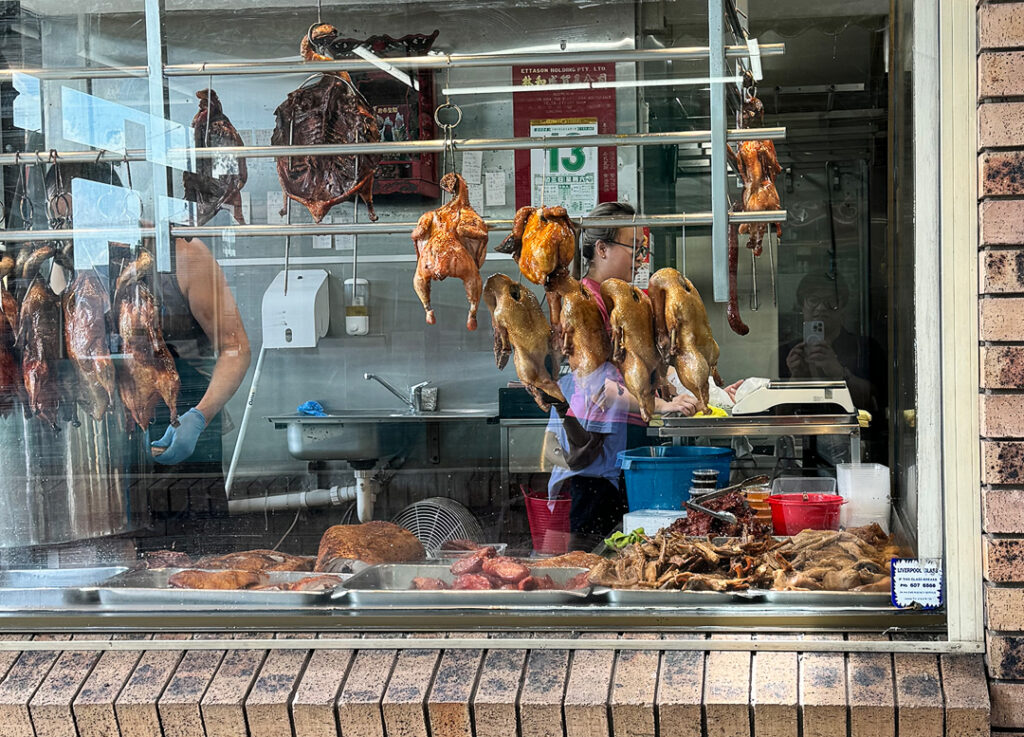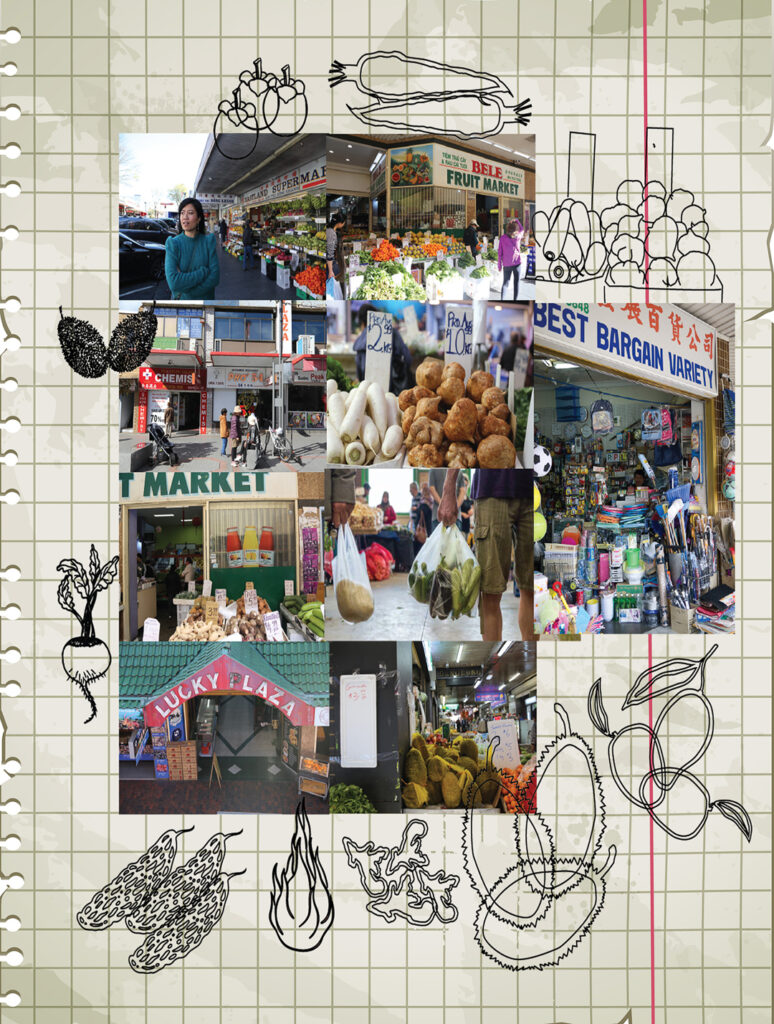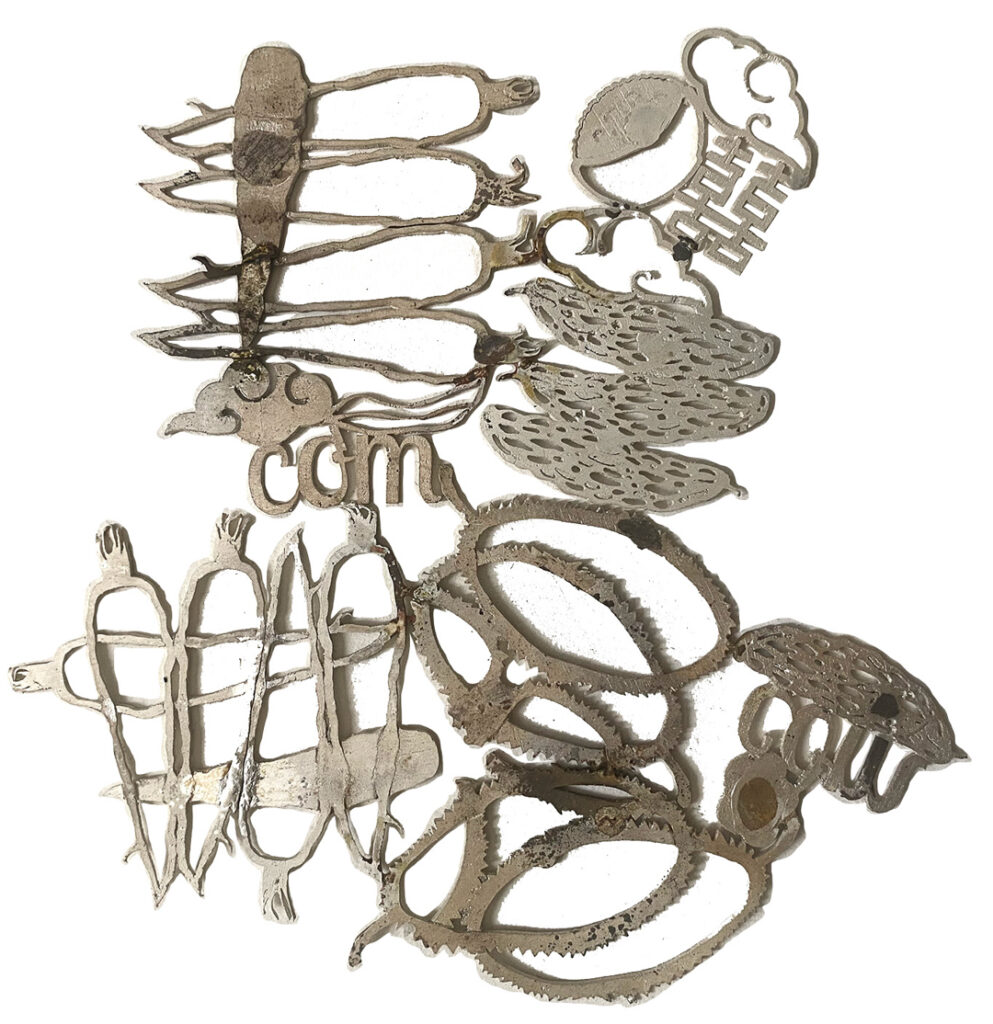Bic Tieu casts her childhood memories of a Sydney Indo-Chinese suburb.
I like to park up high in the Dutton Lane carpark each time I visit Cabramatta. I get lovely vistas of blue skies and clouds touching the rooftops of shopping centres. It overlooks the Gough Whitlam Place, a public space honouring the former prime minister’s work and the strong connection he had with Cabramatta. I wonder if the migrant community is aware of this history. Nonetheless, it has become a popular gathering site for playing xiangqi Chinese chess. As you look around there are traces of oriental green and red roof architecture poking out between buildings. I imagine a sleeping dragon nestled in-between.
A significant cultural asset of Cabramatta is the large ornamental Pailau Gateway guarded by two large bronze lions in the town’s centre. Accompanying these are stone and cement statues of the ox and calf, horse and turtle. They reference freedom, beauty and longevity. Look closer to the Pailau Gateway and you can see that koalas, kangaroos and eucalyptus motifs have been embedded into the design. Celebrating East and West through a visual design is also an aesthetic I like to convey in metal.

View of the Pailau Gateway and details showing the Koala, Kangaroo and Eucalyptus motifs, 2023, photo: Gavino Pili.
These tangible cultural features in Cabramatta’s central business district echo familiarity with the homeland for many Chinese and Vietnamese migrant populations. They celebrate the culture through traditional visual motifs and language. I like the mythical reference and auspicious meanings connecting these symbols. In particular, the ornamental patterns that appear within the architecture. I was really inspired by the amount of sky in the photographic street documentation of Cabramatta. Clouds are a popular motif used in East-Asian popular culture and these lines and scrolls have been worked in as a structural backdrop to narrate some of the objects I am making.
By compositionally placing various scroll clouds in a visual graphic. The network of lines allowed enough space between negative and positive to allow for the layering of motifs to integrate into the visual dialogue. Popular imagery including Chinese characteristics, floral blossoms, and illustrations of animals is integrated. These are continuously constructed slowly forming a bowl vessel. I like that the cloud lines can metaphorically reference olfactory imagery associated with scent. This concept is very fitting for Cabramatta as it is a place associated with food. Even the council welcome sign greets with ‘Discover Cabramatta A Taste of Asia’.

Cabramatta’s streetscape offers a plethora of visual scenes. As you move between John Street, Park Road, Dutton Lane and Hugh Street, amidst arcades and laneways, it is bustling with mixed businesses one after another. As I walk through with my friend photographer, I am reminded of the days when our family did our weekly shop carrying bags of shopping for Mum. Our family knew a lot of the business owners. They were there at a time when many of the Chinese-Vietnamese started their own businesses in the 1980s. My grandfather used to frequent the Tan Hong Phat BBQ shop. He helped the Tan Hong Phat BBQ revise their recipe. Right until he died in the early 90s, he received lots of pork and duck as a gestural thank you. In his other life, he prepared and sold roast duck in Vietnam before arriving in Australia. Places like this allow me to imagine what life for my grandfather would have been like, a street kiosk of hanging ducks, a wooden board and a cleaver.
- Street vendors along John Street and Park Road selling vegetables and plants, 2023, photo: Gavino Pili.
- Lucky gift wares window display of maneko neko, red pockets and dragon plush toys and outside on John Street, 2023, photo: Gavino Pili.
- Shops on Dutton Lane, Park Road and John Street, 2023, photo: Gavino Pili.
John Street is lined with street vendors, bá (older women) selling home-grown veggies across footpaths, lucky gift shops overwhelmingly filled with all sorts of red colours charms greeted by rows of the maneki neko kow towing as you enter. All kinds of hanging accessories to bring in luck in time for the Lunar New Year. Of course, I have to mention all the enticing snacks food and long queues for popular sugar cane juice, mochi cakes and recent establishment artisan tofu by Hòa Húng. Multiple shopping bags filled with fresh produce in hands everywhere. I cannot help but capture this into metal.
- Bic Tieu, sketch and collage of fruit and vegetable vendors, 2023, Digital Journal.
- Bic Tieu, Fruit and Veggies assemblage, work in progress, silver and copper, 2023, Digital Journal.
Cabramatta is one of the few places in Sydney other than Bankstown or Canterbury where you would find it rare to hear the English language. My family can easily converse in Chinese Teo Chew or Vietnamese. The majority of people shopping at Cabramatta are from Indo-Chinese countries. The Vietnamese community is the largest population, followed by the Chinese, Cambodians, Laotians, and Thai people. For this reason, you can see why shop signs are communicated in multiple languages.
Imported product labels are also expressed in multiple languages for the Asian market in Australia. I particularly love the graphics on food packaging. Harmonious characters and lettering sharing the same space represent a lovely metaphor for the different ethnic groups sharing the same place. This physical aspect of Cabramatta inspired the way I incorporate text and imagery together. I liked what these junctions suggested when expressed in metal as a visual graphic. Essentially, I am trying to capture the cultural vernacular of the place.
It is common to come across arcades and food packaging with cultural references. Traditional historical characters like Chinese scholars are found on rice vermicelli packaging, heavenly references of clouds, mythical motifs and floral patterns. Shop names “Lucky Plaza” and food brands like, “Golden Swallow” are associated with auspicious images using homophones to depict family gatherings and harmony. The nostalgia of “going to market” with my family for a meal or doing the grocery. The notion of a deity as a heavenly god inspired ways of composing floating images of bitter melon, Chinese characters and Vietnamese lettering on clouds in metal.
I would cut out and cast in metal food imagery; bitter melon, coriander, durian, mangoes, and in text, Vietnamese words; còm, phò, and cultural objects like clouds, bowls, lanterns. I slowly solder them into sheet forms. From the sheet form, the metal would undergo further shaping and construction to achieve the final form. I use a ball pein hammer and raw hide mallet to shape, raise and sink the sheet metal to create the bowl form.
- Bic Tieu, Bowl vessel, 2023, copper and sterling silver, 100 x 160∅ mm, photo: courtesy of the artist.
Businesses come and go, but Cabramatta still holds the same atmosphere, chaos and nostalgia. The streets are concentrated with eating joints and displays to entice. Shops are crammed with goods overflowing onto the street fronts. I find the stacked compositions and overflowing boxes of seasonal fruits and vegetables lively and inspiring. It’s summer now so mangoes, durian, dragon fruit, bitter melon, and seasonal greens all competing for spaces and finding their way into the visual composition I construct. Like graphic tokens before they become assembled objects. Cast metal allows me to distil and hold these memories to express my experiences with Cabramatta. As I work through the bowl (one in a series of four), I hope it can converse with time, space and place for community and intergenerational migrants of a shared experience.
Further reading
Gapp, Stephen. 2009. Cabrogal to Fairfield City: A History of a Multicultural Community. Fairfield City Museum and Gallery.
About Bic Tieu
 Bic Tieu is a designer, object maker and jeweller. Her works draw on traditional and contemporary craft and design methods inspired by her Asian and Australian cultural lineages to investigate themes of personal and cross-cultural narratives. Specialising in metal technologies, manufacturing processes, and traditional Vietnamese and Japanese lacquer, her practice often utilises a synthesis of these materials to create new perspectives on contemporary object-making and meanings. Follow @bictieustudio and visit www.bictieu.com.
Bic Tieu is a designer, object maker and jeweller. Her works draw on traditional and contemporary craft and design methods inspired by her Asian and Australian cultural lineages to investigate themes of personal and cross-cultural narratives. Specialising in metal technologies, manufacturing processes, and traditional Vietnamese and Japanese lacquer, her practice often utilises a synthesis of these materials to create new perspectives on contemporary object-making and meanings. Follow @bictieustudio and visit www.bictieu.com.
Bic Tieu would like to acknowledge that the material cost for this project was funded by the UNSW School of Art and Design 2023 Research Grant Scheme.













